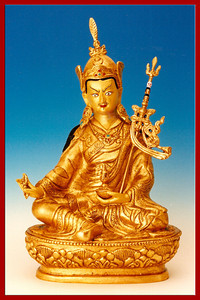An excerpt from a teaching by Jetsunma Ahkon Norbu Lhamo on October 18, 1995
What is it that we actually see when we see the Guru? First of all, the Guru is perfection. The Guru is perfect. The Guru arises very naturally, is spontaneously liberated; there is nothing about this appearance that has become tainted or impure. There is no conceptualization. There is no contrivance at all. We are seeing a natural display of the Primordial Wisdom State. We are literally seeing, in a non-dual way, the union of emptiness and luminosity. Now, of course, because of the way our samsaric minds work, we are not able to understand the non-duality of emptiness and luminosity. We are simply not able to understand that. To us they appear as two nouns. Emptiness is emptiness. We can describe that. Luminosity is luminosity. We can maybe describe that, and so: emptiness-and-luminosity-are-non-dual. The best way to come to that is maybe to say it real quick! That’s about as well as we can do!
What is this non-dual display, this non-duality called emptiness and luminosity? Well, first of all, we must understand that the Lama represents the primordial empty nature, that nature which is completely free of any kind of distinction or contrivance, any kind of ideation, any color, any form, anything that becomes something. The Lama is the display of that which is without beginning and without end, of that which is primordially pure with no change, no movement, no contrivance or distinguishing factors whatsoever. The Lama represents that pure emptiness. When we talk about emptiness in that way, Americans have a difficult time with that; that’s why I’m trying to explain it in common ways, rather than using the traditional buzzwords.
When we think of emptiness, we think of a minus in a sense; like, an empty room is a room without things in it. We think of an empty glass as a glass without liquid in it. That’s the way that we understand emptiness, but in this case, you should understand that emptiness doesn’t mean an “absence of.” Emptiness, in this case, is more like freedom, more like liberation: liberation from conceptualization, liberation from contrivance. The mind does not catch on, the mind does not hook, the mind does not hold in a package – anything. You see? Here, emptiness is liberation. Suppose you were capable at this moment of losing all the fetters, allowing the mind to abide spontaneously, allowing the mind to simply rest in wakefulness. Rest in wakefulness. That is perhaps the closest to how we might understand emptiness.
Luminosity is something we think about as a plus, like a light being on. A light is on or it’s off. Luminosity, we think of as something luminous, so it must be glowing. Of course, that’s not what we’re talking about here either. Let’s say you could attain in your practice that true understanding of emptiness: if one could rest in innate wakefulness, free of contrivance, without any kind of distinction or super-structuring or building or grasping or clinging. Try to imagine a mind such as that. Try to imagine a posture such as that, in a sense, even free of the condition of mind. Try to imagine a posture such as that: innate wakefulness. Then suppose that nature, free of contrivance, were to show itself: gossamer, free, buoyant. There are no words in English to describe it.
From the profound, innate wakefulness that is empty of contrivance, should a display show itself that was like that nature, inseparable from that nature in every single sense; that display was not leaving the state of emptiness in order to show itself; completely indistinguishable from emptiness in the same way that the sun’s rays are completely indistinguishable from the sun itself; that there is no way to tell what is actually the tight hard ball of the sun, and what is the light and heat that comes out of it; that there is no way to tell the difference really: if we could imagine such display, we might call that luminosity. We might say that this profound view of emptiness, this spontaneous, innate wakefulness that is complete and yet unbegun, could somehow show its face in a gossamer, uncontrived inseparable display that you can’t call light, you can’t call movement, you can’t call anything because it has not moved out of that nature. Because we need to use a word we say luminosity, but you must understand that this emptiness and luminosity are indistinguishable from one another. We must also understand that this is what the Lama actually represents.
The Lama represents, therefore, the Primordial Wisdom State: that which is the wakefulness of Buddhahood in dance, in display, in radiance; not separate from the innate nature, yet arising in a completely pure display that is the primordial nature. You have to say “indistinguishable from.” That is what the Lama actually is. You could say that the Lama represents the union of emptiness and movement, or display. You could say that the Lama represents the union of wisdom and method. Guru Rinpoche appears to us always with the dakini. He is always in union with the dakini. Even when we see him in the pictures that we have of him or statues that we have of him, we may see him seeming alone; still, he has in the cleft of his left arm the symbol of the dakini. So in his nature he is never without the dakini. That is a teaching, a very profound teaching for us, as to how to understand the Lama. The Lama, then, is understood as the appearance of the primordial nature, and the display of that nature appearing in our world, in our eyes, in our samsaric existence. The Lama, then, represents the union of emptiness and luminosity.
© Jetsunma Ahkön Lhamo
